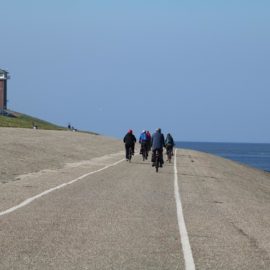
Long desired but never done, the extension of the Tammany Trace may be connected to a Slidell park.
An extension of the Tammany Trace into Slidell’s Heritage Park has been planned for decades, but it’s been slow going over some difficult terrain — both literally and figuratively — for the final stretch of the popular bike and recreation trail that first opened in western St. Tammany Parish in 1994. The long-sought connection is taking a small step forward, however, with a 10-foot wide path that the city of Slidell is building from Heritage Park to Strawberry Street. Not quite a mile long, the $681,000 project at first appears to be a path leading nowhere. But St. Tammany Parish has agreed that it will extend the Trace, which now ends at Camp Salmen Nature Park near Slidell, building it out along an abandoned railroad spur that will eventually connect with the new city path. The pathway, which is being funded in part with federal grant money, will be completed by this fall. It will cross U.S. 190/Gause Boulevard at Carnation Street and will include an island so that cyclists won’t have to cross both lanes of traffic at once, City Engineer Blaine Clancy said. There will also be a button to push to trip the light. “We’ve heard citizens asking … ‘When will you complete the Tammany Trace?’ Today we’re going to get that project started,” Slidell Mayor Greg Cromer said at a ceremonial groundbreaking Thursday. Cromer, who will begin a second term July 1, called the project “a long time coming.”
nola.com
The last local election raised this question on when will it be finished. This is the response, a start.
Public interest in getting the Trace to Heritage Park predates Cromer’s administration, but the issue got more attention during the lead-up to Saturday’s municipal elections, with some City Council candidates questioning why it hasn’t happened yet. But it will still be a while before cyclists will be able to hop on a bike in Covington and pedal all the way to Heritage Park. There’s no timetable for the larger project, and the cost could top $10 million, according to St. Tammany Parish spokesperson Michael Vinsanau. So far, the parish has agreed to use just over $1.2 million in money from its share of the Deepwater Horizon settlement, Vinsanau said, and Slidell has committed $600,000. There are two significant challenges for the parish portion of the work: the Trace will have to cross three railroad bridges that have been out of service for some time. An inspection project, which began last year, will determine if repair or replacement is needed. Until that report is finished, the full scope and cost will be unknown. The other challenge is crossing busy U.S. 190, likely near Williams Road in a curved section that has over 18,000 vehicles every day. The crossing poses concerns for safety and, if a tunnel is required, additional costs, Vinsanau said.
The Parish is starting a feasibility study so if the money can be found the plan is set.
The parish has hired an engineering firm to study the project’s feasibility. Principal Engineer is looking at vehicular traffic along U.S. 190 and bicycle and pedestrian traffic along the existing Trace to determine how best to cross the highway. The final report will include an environmental checklist, conceptual design alternatives and preliminary construction cost estimates. It’s expected to be done by the end of the year. Once that’s in hand, the next step will be finding the money. Parish President Mike Cooper said he is committed to completing the connection, noting that it will prove more than 30 miles of bike trails connecting Covington to Slidell. “My administration will continue to identify and pursue innovative funding sources to make this project a reality,” he said. But if extensive bridge repair is needed or if a tunnel crossing is required, the price will be steep. Tunnels have been built in two other spots where the Tammany Trace has to cross highways, both of them in western St. Tammany Parish. The most recent, where the trail crosses Louisiana 59, was completed last fall at a cost of $3.5 million.
A lest costly alternative had been suggested but was thrown out after many objections were raised.
Slidell officials had pursued a less expensive plan, which would have used bike lanes on residential streets to connect the Trace to West Hall and into the park. But that plan triggered outcry from people in those neighborhoods and was discarded in favor of using the abandoned railroad spur. Among other arguments, they said their neighborhoods would be the only ones in the parish to carry Tammany Trace traffic. The recreational path was built on the abandoned Illinois Central Railroad line and was the first rails-to-trails project in Louisiana. Blaine Clancy, a Slidell city engineer, said the initial route wasn’t feasible. The affected areas are older neighborhoods, built for a time when people had one car instead of multiple vehicles, and cars would have blocked a bike lane. Council member at large Bill Borchert on Thursday credited Cromer with taking the lead on getting the route for the final stretch moved. “We tried to bring it up West Hall, but that just wasn’t the way to go,” he said. “Communities that are considered to be progressive, forward-thinking communities, they have recreational aspects to their communities,” Borchert said. “They have biking trails, walking trails … Slidell has been left out of that for the past 20 years as far as St. Tammany Parish goes.”
From this I can expect efforts will be made to build it. Are their any rich benefactors in the Parish who will donate?



